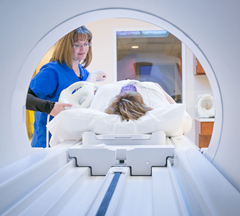Do These Seizures Mean Epilepsy?

Find Your Perfect Match
Answer a few questions and we'll provide you with a list of primary care providers that best fit your needs.
Chances are, the first thing you think of with epilepsy is a person having a seizure: someone with muscle spasms and jerking movements, falling to the ground, or losing consciousness.
Seizures also may take other forms, with a person staring, blinking rapidly, or showing confusion. They occur when the normal connections between nerve cells in the brain are interrupted. A high fever, high or low blood sugar, withdrawal from alcohol or drugs, or a blow to the brain all can cause a one-time seizure.
What defines epilepsy is having two or more seizures without a known cause.
Epilepsy affects about 3.4 million Americans (that’s one in every 26 people), including 470,000 children. It is the fourth most common neurological disorder.
“Seizures are the hallmark of epilepsy. They are the symptom that defines the condition,” Dr. Phillips says.
Symptoms and Causes
Seizures are the main symptom of epilepsy.
“Epileptic seizures have symptoms that vary depending on where they come from in the brain,” says Barbara Phillips, MD.
Some people blank out for a short time or become confused. Others have strong, involuntary movements. If a seizure lasts more than five minutes, you should call 911.
Dr. Phillips talks about the most common types of seizures.
Click play to watch the video or read video transcript.
“Seizures are the hallmark of epilepsy. They are the symptom that defines the condition,” Dr. Phillips says. “There are other conditions and problems that epileptic patients tend to get.”
For example, many people with epilepsy also experience memory problems and depression. Over time, people with severe seizures that cannot be controlled with medication or surgery may have changes in thinking ability and personality.
Epilepsy tends to run in families and can develop at any age – but mostly commonly in childhood and after age 65, Dr. Phillips says. It also can develop following trauma to the brain from a stroke or head injury. An infectious disease or developmental disorder may be the cause. For about 60 percent of people with epilepsy, the cause is unknown.
Dr. Phillips discusses the causes of epilepsy.
Click play to watch the video or read video transcript.
Doctors diagnose epilepsy with extensive interviews and imaging studies such as MRIs and CT scans that can measure electrical activity in the brain.
Left untreated, epilepsy can limit a person’s lifestyle and activities. For example, some states don’t allow people with epilepsy to have a driver’s license. They may be restricted in the types of machinery they can operate or cautioned not to do certain recreational activities.
Dr. Phillips explains how epilepsy is diagnosed.
Click play to watch the video or read video transcript.
Can Epilepsy Be Successfully Treated?

Epilepsy cannot be cured, but about 70 percent of people who have epilepsy can control their seizures through medications and/or surgery.
Treatment options include:
Medications. These are the front-line treatment for epilepsy, and there are many medications for different types of epilepsy. A neurologist who specializes in treating epilepsy will work with people to find the most effective dose with the fewest side effects.
High-fat diet. A noninvasive option includes following aketogenic dietthat’s very high in fat and very low in carbohydrates. The diet increases production of ketones, chemicals made from the breakdown of body fat that provide an energy source for the brain and heart. This diet helps reduce seizures for some people with epilepsy, although researchers cannot explain why. It is most often used with children
Surgery. If medications or diet aren’t effective in controlling seizures, surgery may be an option. One approach is to remove abnormal areas of brain tissue to eliminate where the seizures start.
Dr. Phillips explains the most common surgical treatment options for epilepsy.
Click play to watch the video or read video transcript.
Vagus nerve stimulator: Another treatment technique is called a vagus nerve stimulator, which uses small, implanted wires in the neck around one of the vagus nerves to send energy impulses to the brain that can help stop a seizure.
Brain implant. A device implanted directly into the brain detects seizure activity and automatically stimulates the brain to stop the seizure.
Dr. Phllips talks about innovations in the treatment of epilepsy.
Click play to watch the video or read video transcript.
Find Your Perfect Match
Answer a few questions and we'll provide you with a list of primary care providers that best fit your needs.
Source: healthychildren.org; What to Expect; American Academy of Pediatrics; Barbara Phillips, MD, Clinical Neuroscience Institute










